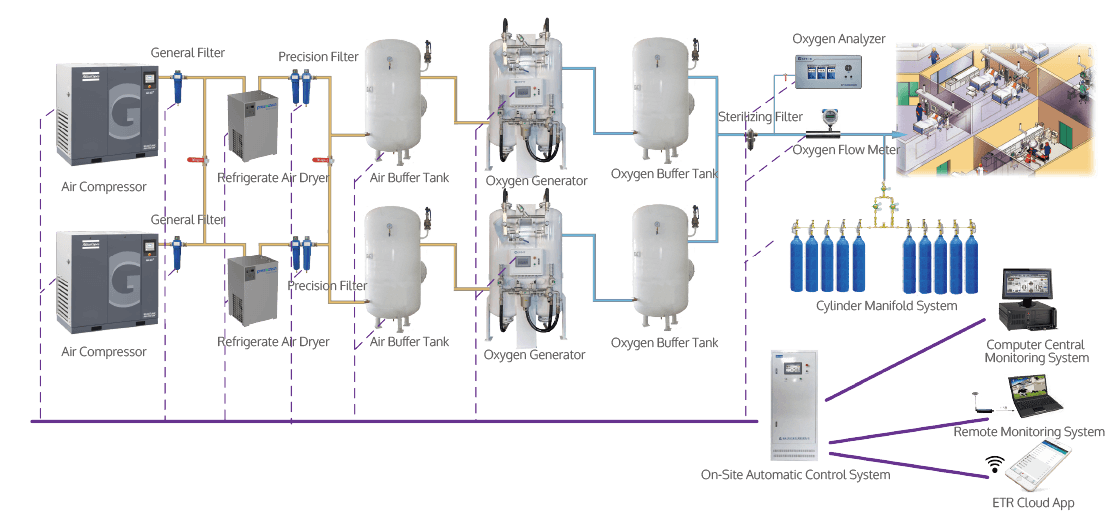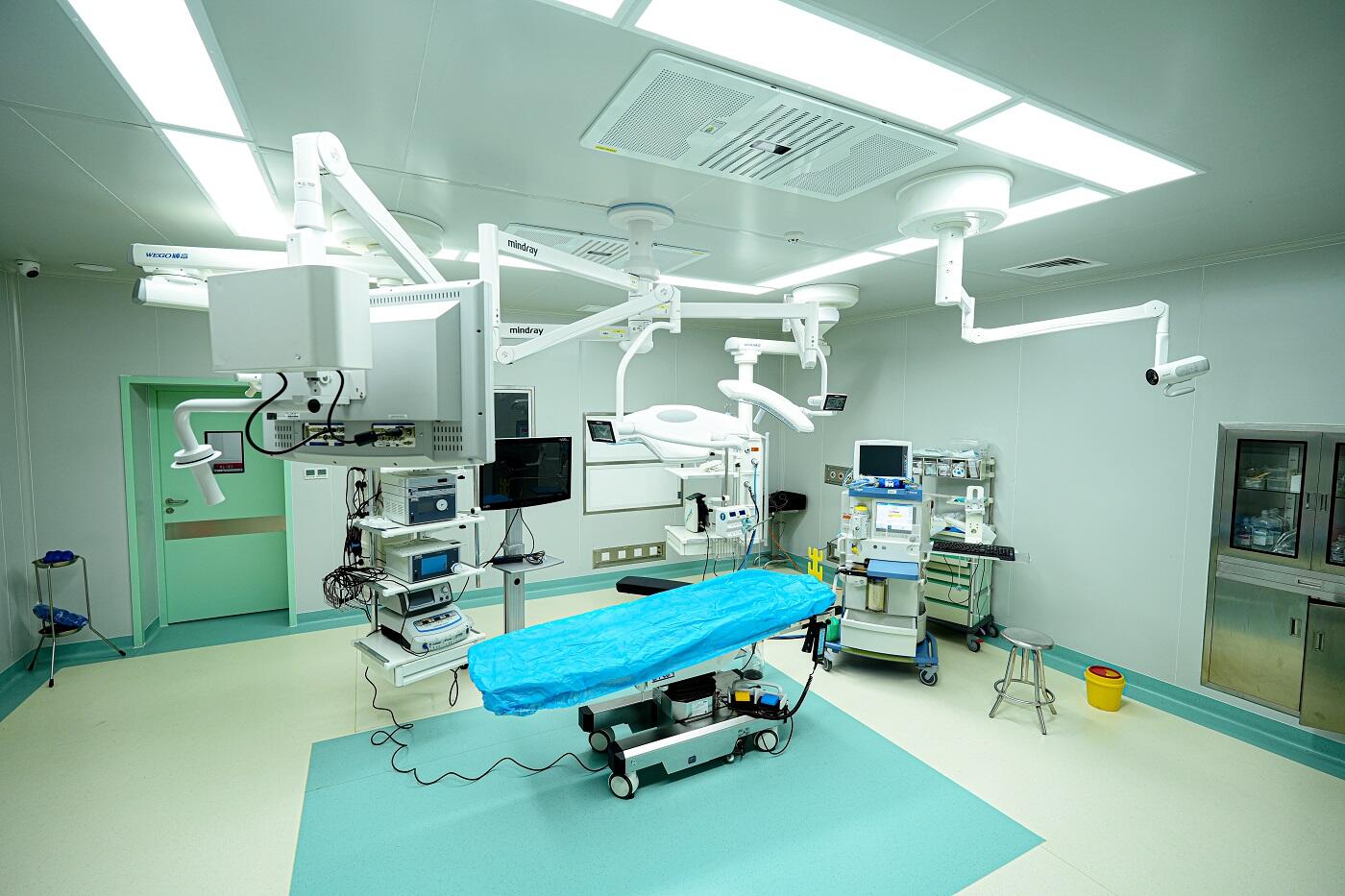Hospital-grade oxygen system: the "invisible heart" behind life support
The oxygen patients breathe in intensive care units and during surgeries depends entirely on the hospital's oxygen production system working properly. Think of it as something behind the scenes that makes sure medical staff have what they need when seconds count. Without this system turning regular air into medical grade oxygen, many treatments simply wouldn't work. Hospitals rely heavily on these systems to combat low oxygen situations, ensuring patients get the right amount at critical moments throughout their treatment journey.
Core position: Revolution from steel cylinder transportation to "oxygen water pipe"
The evolutionary history of the speed of life and death
The era of steel cylinders (before the 1980s): Industrial oxygen was the main source, containing impurities such as carbon monoxide and dust. Inhalation by patients could easily cause coughing and even pulmonary edema.

Centralized oxygen supply era began back in 1983 when China introduced its first such system. Oxygen started flowing directly into hospital wards via pipelines, which meant nurses no longer had to haul heavy steel cylinders up multiple flights of stairs. This change boosted overall efficiency quite dramatically - some reports suggest around three times better performance compared to what came before. Fast forward to the 2020s and we enter the smart age. Hospitals now commonly use PSA oxygen concentrators combined with IoT monitoring systems. These setups allow for oxygen delivery exactly when needed, almost like magic really. The technology is so precise that mistakes happen less than once out of every thousand deliveries. Patients get what they need right on time while hospitals save money and reduce waste.

Most modern hospitals have three essential systems built right in. First, there's the central oxygen supply system which delivers at least 90 percent pure oxygen throughout the facility. Then comes the central suction system that handles the removal of sputum and surgical waste liquids using negative pressure. Lastly, compressed air systems power important medical equipment like ventilators and anesthesia machines. Looking at actual numbers gives perspective on just how much these systems work. Tertiary hospitals typically consume over 5000 cubic meters of oxygen each day. To put that into context, this amount would fill about two standard sized swimming pools completely full.
Core technology: how to "extract" essence of air from PSA oxygen generator
Four step separation technique: transformation from air to medical oxygen

Molecular sieve sniper battle: Nitrogen molecules (3.64 Å) are captured by zeolite micropores, while oxygen molecules (3.46 Å) penetrate and output.
Aseptic defense line: The sterilization membrane intercepts 99.99% of bacteria, preventing respiratory infections.
• Safety redundancy design: Triple insurance without oxygen interruption
Efficiency showdown: Why does PSA oxygen concentrator crush liquid oxygen/steel cylinders?
Looking at the economics makes sense when comparing different oxygen supply options. For PSA oxygen generators, the electricity consumption comes out to roughly 1.2 yuan per cubic meter. Liquid oxygen systems are significantly more expensive upfront at around 3.2 yuan per cubic meter, plus there's the added hassle of needing certified personnel for daily operations and maintenance. Then we have those standard gas cylinders (the 40 liter ones) which typically cost about 25 yuan each in Changsha, but honestly most people only get about 70% usage before they're thrown away because nobody wants to deal with the leftover pressure. Just keep in mind these numbers can fluctuate depending on what specific project requirements might dictate regarding pricing constraints.
Clinical battlefield: life span from ICU to high-altitude outpost
Intensive Care Unit (ICU)
ECMO oxygen supply: The oxygen production system provides 99.5% pure oxygen to the extracorporeal membrane lungs, reducing the risk of blood infections;
Premature infant incubator: Moist constant temperature oxygen (33 ℃± 1 ℃, humidity 60%) protects the alveoli of newborns.

Emergency treatment at high altitudes faces unique challenges, especially around 5000 meters where oxygen levels drop significantly. Posts in these areas typically have special PSA oxygen concentrators designed for thin air conditions. These devices maintain an impressive 90% oxygen concentration even when regular equipment struggles to reach just 70%. For mobile emergency response, there's also a vehicle-mounted oxygen system that can provide breathable air for about 30 minutes at a time. During the devastating Wenchuan earthquake, this kind of portable setup was instrumental in rescuing approximately 100 individuals who might otherwise have succumbed to altitude sickness or other complications from lack of oxygen.
Operating Room 'Oxygen Storm'

• Open chest surgery: instantaneous oxygen demand reaches 100L/min, with dual supply of liquid oxygen storage tank and PSA;
Laser surgery: High purity oxygen assisted laser knife, with an error of less than 0.5%, can avoid tissue burns.
Hospital grade oxygen systems combine cryogenic techniques with molecular sieve technology, all connected through smart IoT monitoring for patient care. These systems typically incorporate three separate oxygen sources as backup measures, ensuring continuous supply even during failures. A critical component is the 0.22 micrometer filter that blocks harmful contaminants before they reach patients. There are three key performance indicators to keep in mind when evaluating these systems: first, the oxygen concentration should maintain at least 90%; second, operating pressure must stay below 8 atmospheres; and third, any faults need to be detected and addressed within just 0.1 seconds to prevent complications.



